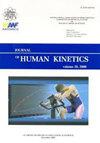The Effects of Players’ Rotations on High-Intensity Activities in Professional Futsal Players
IF 1.9
3区 医学
Q2 SPORT SCIENCES
引用次数: 0
Abstract
The current study aimed to investigate the effects of interchange rotations on players` physical performance during competition, with special reference to high-intensity activity (HIA) according to the playing position. Physical performance data, collected from 19 professional players during seven official matches from the Spanish futsal league using a portable local positioning system, included the number of high-speed running activities (>18 km∙h−1), high-intensity accelerations (>3 m∙s−2), and high-intensity decelerations (>3 m∙s−2). Statistically significant (p ≤ 0.05) differences were observed in the number of HIA efforts across rotations and between positions. Players performed more HIA efforts in the first rotation (n = 17.6), suggesting that their first rotation was more demanding than all subsequent rotations. Wingers demonstrated a higher HIA effort and frequency of HIA efforts when compared to defenders (p ≤ 0.05) and pivots (p ≤ 0.001). For all positions, the first rotation was more physically demanding as the number of HIA efforts per rotation decreased with an increased number of rotations throughout the match. Furthermore, higher HIA profile positions, such as wingers and defenders, were less likely to maintain consistent HIA properties (repetition number, time-frequency, and the work-rate) across subsequent rotations during the match. The findings of the study can inform coaching decisions regarding players’ rotations to maintain consistent HIA performance throughout the match.轮换对职业五人制足球运动员高强度运动的影响
本研究旨在探讨换位轮换对运动员在比赛中身体表现的影响,并特别参考了根据比赛位置的高强度活动(HIA)。使用便携式本地定位系统从西班牙五角制足球联赛的七场正式比赛中收集了19名职业球员的身体表现数据,包括高速奔跑活动(18公里∙h−1)、高强度加速(3米∙s−2)和高强度减速(3米∙s−2)的次数。不同旋转和不同体位的HIA次数差异有统计学意义(p≤0.05)。玩家在第一次轮转中表现出更多HIA努力(n = 17.6),这表明他们的第一次轮转比随后的轮转要求更高。边锋的HIA次数和HIA次数均高于后卫(p≤0.05)和中路后卫(p≤0.001)。对于所有位置,第一次轮换对体力的要求更高,因为每次轮换的HIA次数随着比赛中轮换次数的增加而减少。此外,HIA较高的位置,如边锋和后卫,在比赛的后续轮换中不太可能保持一致的HIA属性(重复次数、时间频率和工作率)。研究结果可以为教练提供有关球员轮换的决策,以在整个比赛中保持一致的HIA表现。
本文章由计算机程序翻译,如有差异,请以英文原文为准。
求助全文
约1分钟内获得全文
求助全文
来源期刊

Journal of Human Kinetics
医学-运动科学
CiteScore
4.80
自引率
0.00%
发文量
83
审稿时长
3 months
期刊介绍:
The Journal of Human Kinetics is an open access interdisciplinary periodical offering the latest research in the science of human movement studies. This comprehensive professional journal features articles and research notes encompassing such topic areas as: Kinesiology, Exercise Physiology and Nutrition, Sports Training and Behavioural Sciences in Sport, but especially considering elite and competitive aspects of sport.
The journal publishes original papers, invited reviews, short communications and letters to the Editors. Manuscripts submitted to the journal must contain novel data on theoretical or experimental research or on practical applications in the field of sport sciences.
The Journal of Human Kinetics is published in March, June, September and December.
We encourage scientists from around the world to submit their papers to our periodical.
 求助内容:
求助内容: 应助结果提醒方式:
应助结果提醒方式:


